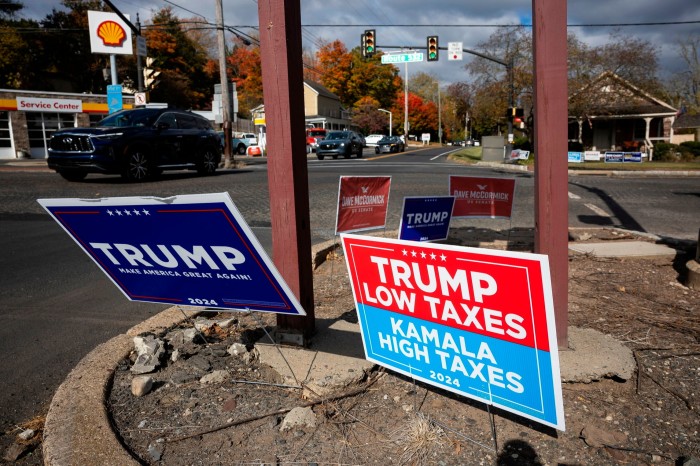If you live outside a swing state, you might — if you really try — almost forget there is a tumultuous US election under way. If you live inside one, not so much.
Lawn signs. Billboards. Text messages. So many text messages. In the seven battleground states that will decide the US election, political ads are everywhere, all the time. The White House race is inescapable.
As one of the tightest presidential elections in living memory enters its final days, Kamala Harris and Donald Trump are criss-crossing the country to make their final pitch to voters in the swing states.
Their campaigns are there 24/7. While some people elsewhere in the US can tune out of the frenzy, voters in Arizona, Georgia, Michigan, Nevada, North Carolina, Pennsylvania and Wisconsin are being inundated with some of the most sophisticated and targeted messaging and advertising in political history.
And some of that is just downright blunt.
There are the classic campaign placards pitched on lawns and in windows and crowding verges along roads, as well as television ads flooding the airwaves.
Added to the campaigns’ arsenals are digital ads, particularly on social media, and a steady stream of personalised text messages pleading for donations and urging people to turn out to vote on November 5, or before.
The 2024 election is on track to be the most expensive ever, with the vast majority of funds going to advertising.
The Harris campaign and its affiliated committees have pumped more than $1.1bn into advertising, almost double the $602mn spent by the Trump campaign and its aligned committees, according to the FT’s ad tracker.
The swing states that will decide the vote have received $1.36bn of the two campaigns’ combined spending. The biggest share — $373.5mn — has gone to Pennsylvania, considered the most crucial battleground state.
“I think everyone is just ready for it to be over,” said Tracee Malik, a real estate agent from the Pittsburgh area. “Pretty much the only commercials that we have now are the political commercials.”
Harris’s most-aired TV spots have focused on her prosecutorial and middle class background, defence of reproductive rights, and claims that Trump cares only about the wealthy. Others focus on her rival as being “too unstable to lead”.
Trump’s most-aired ads have been about the economy, blaming Harris and President Joe Biden’s economic agenda for the high cost of living. But his most played spot attacks the vice-president for supporting gender affirming care for prison inmates, telling voters: “Kamala’s agenda is they/them, not you.”
In Pennsylvania, Arizona and Nevada, Trump ads also slam Harris over immigration, while in Georgia and North Carolina, pro-Harris ads concentrate on abortion rights.
Is the barrage working? It’s unclear.
FT Edit
This article was featured in FT Edit, a daily selection of eight stories to inform, inspire and delight, free to read for 30 days. Explore FT Edit here ➼
“I hate that advertising,” said Vallon Laurence, a retired member of the US Navy who lives in Atlanta, Georgia. “If you go by the advertising . . . you don’t want either one of them.”
Local issues also feature in the campaigns. Pro-Harris ads in North Carolina link Trump to Mark Robinson, the Republican gubernatorial candidate who has been embroiled in a scandal over allegations — vehemently denied by him — that he posted racist comments on a pornography website.
Simultaneously, pro-Trump groups are sending texts assailing Harris and the Biden administration for a slow recovery effort from Hurricane Helene, which devastated the western part of the state.
On social media, the campaigns can target small groups of voters, tailoring content based on age, gender or even interests using memes, news or a chain email format.
The Harris campaign has spent more than $10mn promoting generic-looking Facebook pages with titles such as “The Daily Scroll”, boosting favourable news articles.
Democrats have also taken advantage of digital targeting tools to address women, particularly on abortion rights, blaming Trump for the Supreme Court’s overturning of Roe vs Wade.
More than a quarter of the Harris campaign’s Facebook and Instagram ads have been seen by an audience that is at least two-thirds women. Virtually none had the same margins for men.
Pro-Harris super Pacs — political action committees, or fundraising and spending groups, that aren’t allowed to co-ordinate with the campaigns — have been targeting women even more aggressively: 51 per cent of their Meta ads reached a predominantly female audience, compared to only 2 per cent at equivalently male audiences.
But irritation with the flood of propaganda has spread, even to down-ballot races. A ferocious battle for a US Senate seat from Montana — which could decide which party controls the upper chamber of Congress — has exhausted local residents.
The state has had the highest ad spending per voter in recent weeks, surpassing the battlegrounds, according to Financial Times analysis.
“It just hits you in the face,” said Emma Fry, 21, a student in Bozeman who recently came home to find a pile of political flyers and letters on her porch.
“They’re absolutely everywhere. And at some point people are just annoyed,” she said. “We’ve got to pray for the day it’s just over, because we need to wrap this up.”
Additional reporting by Myles McCormick in Atlanta and Bozeman, Montana, and Oliver Roeder in New York; video editing by Jamie Han















